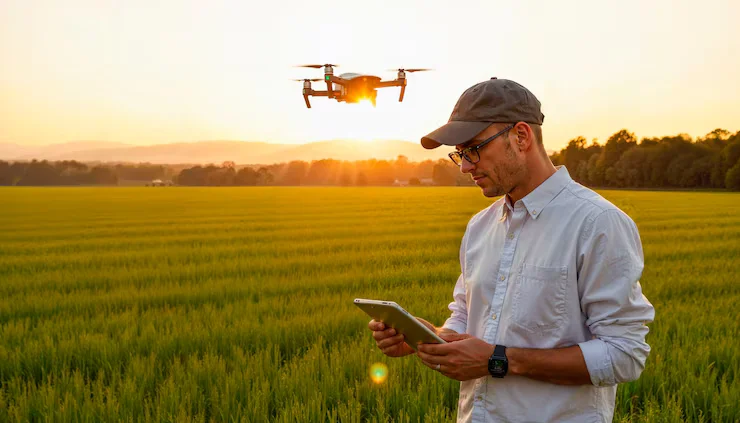Keeping an eye on your crops has never been more important or more difficult. Rising costs, labor shortages, and unpredictable weather make it increasingly challenging for farmers to manage their fields in a traditional manner. That’s where drone technology is offering an innovative solution.
Agricultural drones are changing how farmers monitor crops, detect problems early, and apply inputs efficiently. In India, adoption is picking up pace thanks to services like Leher Spraying Drones, which help farmers access drone technology without needing to own the equipment.
Here’s how drones can help you make smarter, faster farming decisions.
1. Monitor Crops Faster and Better
Manually scouting fields is time-consuming, and even then, some issues go unnoticed. With drones, you can scan an entire field in minutes. High-resolution cameras and GPS-based mapping systems give you a detailed overview of plant health.
Some services, such as Leher Spraying Drones, use advanced sensors and GPS technology to capture accurate data on crop growth, dry patches, or pest-prone zones. This allows for quicker decisions and better planning without needing to walk every corner of the farm.
2. Spot Problems Early—Before Damage Spreads
Many crop losses happen because pests or diseases go unnoticed until it’s too late. Drones equipped with multispectral and thermal sensors detect subtle changes in plant color and temperature, which are early indicators of potential trouble.
Leher’s drone systems are designed to identify these stress signals, giving farmers time to act before the issue spreads. Targeted action early on also reduces the need for large-scale spraying later, lowering chemical usage and crop damage.
3. Smarter Input Use, Lower Wastage
Traditional spraying methods often lead to overlapping, overspraying, and uneven coverage. This not only wastes inputs but also harms soil health.
Leher’s drones are equipped to deliver precision spraying, with GPS-enabled targeting and sensor-guided nozzles. This ensures even distribution of pesticides and fertilizers, helping reduce chemical waste by up to 70% in some crops. This level of accuracy enhances absorption, resulting in improved plant health and lower costs.
In fact, Leher’s core offering is designed to cut spraying time from 4 hours to just 5 minutes per acre, while improving yield by 30–50%, depending on the crop and conditions.
4. Save Time and Cut Labor Costs
With fewer workers available and rising wages, labor has become one of the biggest challenges in Indian agriculture. Drones offer a way to complete tasks more efficiently, without relying heavily on manual labor.
Farmers using drone services report saving up to 20–30% on operational costs. Leher Spraying Drones, for example, allow you to book a drone service via a mobile app or WhatsApp. You can schedule, track progress, and make payments, all without leaving your field.
Leher’s autonomous mechanization model is designed to address these gaps by reducing dependency on manual labor and increasing farming efficiency.
5. Reduce Health Risks from Chemical Exposure
Manual spraying exposes farmers to hazardous chemicals. This is especially risky when protective gear isn’t used correctly, something that’s still common in many areas.
Drone spraying solves this by keeping farmers away from direct exposure to pesticides. Trained operators remotely manage drones, while the machines handle the spraying. This approach protects your health and ensures that the chemical is applied evenly and safely.
Leher’s drones are specifically designed to reduce drift and exposure, supporting both safety and environmental goals.
6. Create Local Jobs While Modernizing Farming
Drones don’t just support farms; they also open new job opportunities. As demand for drone spraying rises, rural youth can train to become certified drone operators.
Leher Spraying Drones operates a Drone Partner Program that provides training, financial support, and a consistent stream of service requests. Operators can earn a sustainable income by serving farmers in their region, providing high-quality services to the farming community.
This approach not only builds skills but also keeps the benefits of new technology rooted in local areas.
7. Reduce Crop Loss Due to Weather Delays
When pests strike or weather conditions shift, response time matters. Spraying manually can take days, and by then, the damage may already be done.
With drones, one operator can spray dozens of acres in a single day. Leher Spraying Drones are capable of covering up to 50 acres daily, making it easier to respond quickly before rainfall, winds, or pest outbreaks cause more harm.
This fast turnaround protects your crops and reduces the need for repeat applications.
Final Thoughts
Agricultural drones offer real, practical value—especially for farmers managing large plots, costly inputs, or recurring crop health issues.
From early problem detection to accurate spraying, drones help save money, reduce labor, and improve yields. Leher Spraying Drones are helping farmers across India access these tools without significant upfront investments.
If you’re thinking about smarter ways to run your farm, it might be time to take a closer look at how drones fit into your plan.
